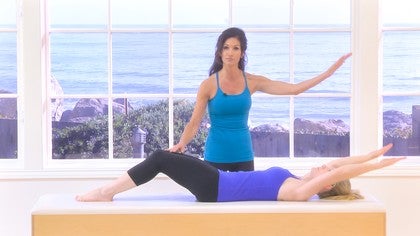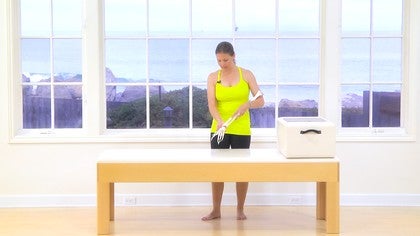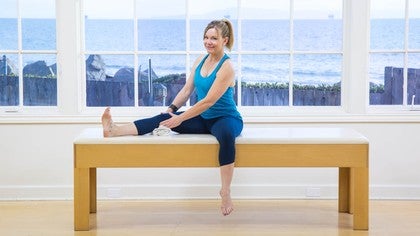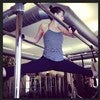Description
About This Video
Transcript
Read Full Transcript
Hi, I'm Shelly power from Pollstar plotters in Miami. And today we're going to talk about wrist pain and the common common complaint that we get in math classes especially, but sometimes on the equipment. Wow, my wrist really hurts when I put weight on my hands when I have to do anything in weight bearing. Gosh, my wrist really hurts. So we're going to talk about why that happens in general and what you can do about it. So you can go through your math classes with less discomfort, hopefully none. Uh, if you can incorporate all of these things. So what we like to talk about here when we're talking about the wrist pain is we can talk about the wrist bones. You can see that there's a lot of small little bones that connect the arm to the hand and you can look at it from both sides.
This is from the palm side of your hand and this is from the back of the hand, these wrist phones. And what's important to know or to remember if you knew it before that there's no little muscles just around the wrist that are there to support the bones, right? That this doesn't happen like that. The muscles that we're going to talk about and that are really important are the forearm muscles that come down into both sides of the hand. So we have all this for our muscles that help us to either move the hand in this direction or this direction and then there's some intrinsic muscles in the hand and into the fingers that help us to be able to move both into a fist and open out. But you can also move your fingers in this direction, which we don't really explore that or talk about that very much. The fist is the fist is common, but this other movement is not and what we call that is a lumbrical.
The muscles themselves are called lumbricals and the lumbrical grip because they happen throughout the hand and they let us move the hand that way. And the reason that's important is because being able to make a little scooped or hollow place in the hand is important. So I explain it sometimes. Like if you are going to palm a basketball, right, if you were going to pull it up and be able to hold it here, you'd want to be able to make that shape with your hand and that prevents the weight of your body from sinking down into your hands, which is where it becomes uncomfortable. So when you're putting your hands down on the mat, when you're getting ready to go into something like a pushup or a pushup position or a plank, if you can push down through your fingers a little bit and almost feel like you're making a little bit of space under your hand, that's going to help you. And it's a co contraction.
It's a co contraction of the muscles on both sides of the arm and hand that provide for that increase in strength. And in Yoga, you may have heard if you've done yoga classes, the talk, the PE teachers talk about Bhandas and the word bonding means to lock literally. Um, it also means to tighten her to hold. And that's what we're doing. We're strengthening this co contraction, this bond around the wrist to be able to have good support. Okay? And it takes time. It takes time to condition these muscles. We hardly ever spend time weightbearing on our hands. I mean, you just don't do it any longer.
You are probably three or four or five in the last time that you got down on the floor and really put a lot of pressure on your hands. So it takes time to condition all of the muscles and all of those surrounding tissues. So don't expect that this is just going to be solved right now. It's going to take some time just like getting ready to do any activity, you're going to have to practice. So this is going to take some practice to take breaks when you need to move your hands and wrists around, but keep practicing because the more you do that, the easier it becomes and the less painful that it is. Another really important thing with that is what's happening through the shoulder girdle, right through your shoulders and your upper back.
If you get ready to get into a, say a quadriped head position where you're on your hands and knees and your body saggy like this, that also tends to put a lot of weight down. You can use the muscles around your shoulders, especially if you feel almost like you're going to slide your hands apart when you're in the position. Don't move them but pretend like it and you're going to have that feeling of increased support through your shoulders. Okay? Another thing you can do if you really have wrist pain, that is not going to go away if some people do have, they have carpal tunnel syndrome and other things that really, um, prevents you from being comfortable. So you can do a couple different things to prevent that from being so bothersome. One is to simply prop up the heel of your hand.
If the heel of your hand is a little bit higher than the fingers, it's often more comfortable because you don't have that feeling of sinking down. It's propped up a little bit. There are lots of products on the market. They have gloves and different things that have little bits of padding in them, which does the same thing, which is nice because you don't have to, um, always remember to bring one of these little pieces of foam with you. You can just simply have the gloves on. That's great. Um, you can also, if you're on your mat and your mat is a little bit thicker, move to the edge. So if this was my mat extended this way, you just come up to the edge and put your hands again to prop up on the edge of the mat and be aware of your mat is really squishy.
If you have a really luxurious, soft, thick mat, the heels of your hands are going to sink down. So that might not be the best option. So you wanna just take a look, take a look at that and that will help you. Um, sometimes it seems strange, but a hard surface, a hard floor is actually more comfortable because you can get that support. Uh, what you have on the apparatus when you're using the apparatus is, especially on the foot bar, you have the capacity to move your hand all around the foot bar. So make sure you're not setting your hand up on the foot bar where it's low, your wrist is low, get your hand up on top. And again, if you send your fingers out, you spread them out in that direction. Again, you're going to start to get that Koch contraction around your forearm, less pain, less discomfort. One more thing you can try for this. If you have a box or you have something at home that is around this height, could be anything even a footstool. You can take this and you can place your forms on it.
So instead of being on your hands, you could be instead on your forearms and you can do all the same movements that you would do on your hands here in this position. And it's possible to do this on the reformer, on the trapeze table. A lot of options for using the box to get up off of your hands. So I hope that this has been helpful. I hope you've found out some tricks. One thing, again, I'll remind you, you need to practice.
You need to condition the muscles and get your body used to doing these movements. Don't be, don't be surprised if when you're doing this for a while, it's uncomfortable. Slowly with a lot of practice, you're going to build the endurance to be able to be on your hands for long periods of time with no pain. Hope this has been helpful and we'll see you again soon.
Begin Pilates: Modifications for Classes
Comments
This was so helpful Shelly Thank you :)
Great tips, I will definitely think about your advice, and share it amongst all my clients to prevent wrist pain from ever happening!
#iampolestar
You need to be a subscriber to post a comment.
Please Log In or Create an Account to start your free trial.


























